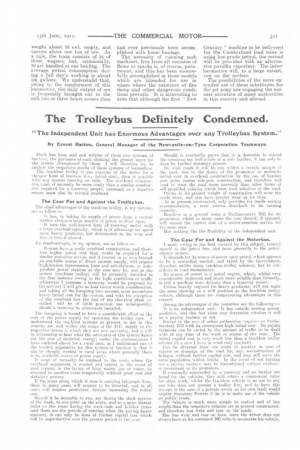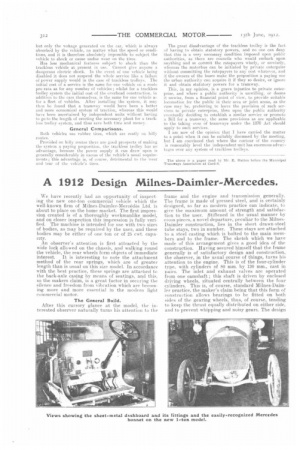The Trolleybus Definitely Condemned.
Page 9

Page 10

If you've noticed an error in this article please click here to report it so we can fix it.
"The Independent Unit has Enormous Advantages over any Trolleybus System."
By Ernest Hatton, General Manager of the Newcastle.-on-Tyne Corporation Tramways.
Much has been said and written of these two systems of traction, the partisans of each claiming the greater merit for the system championed by them. I will therefore try to analyse the respective merits of these systems of locomotion.
The trackless trolley is the outcome of the desire for a cheepee form of traction (i.e., initial cost), than is possible with any system running on rails. The overhead censtruction must of necessity he more costly than a similar construction required for a tramway proper, inasmuch as a negative return must also be erected overhead.
The Case For and Against the Trolleybus.
The chief advantages of the trackless trolley, in my opinion, are as follow :— ft has, in taking its supply of power from a central station always a large reserve of power to dietw upon. It uses the well-known form of tramway motor with a large overload capacity, which is of advantage for speed upon heavy gradients, but detrimental to the wear and tear or tires if abused.
Its disadvantages, in my opinion, are as follow :—
It must have a costly overhead construction, and therefore higher initial coot than would be required for a similar motorbus serviee and if located in an area beyond an available source of direct current supply, will require high-tension transmission lines and sub-stations, or independent power stations as the ease may be, and as the system (trackless trolley) will be primarily installed in the first instance owing to the light conditions of traffic (otherwise I presume a tramway would be proposed for the service) it will give no load factor worth consideration, and taking all the foregoing into account must necessitate heavy initial ciwt, for the ,iystem, and with the exception of the overhead line the rest of the electrical plant installed will be of little practical use subsequently, should a tramway be afterwards installed.
The foregoing is bound to have a considerable effect on the cost of the power supply for operating the trolley cars. I. understand the trackleos syoteins at present in use in this country are well within the range of the D.C. supply in the respective towns in which they are now operating, and it will he interesting to hear what the advocates of this system figure
out the cost of electrical energy, under the circumstances I have outlined above, for a rural area, as I understand one of the leading arguments for this system of traction is that it can be cheaply worked in rural areas where generally there is no available source of power supply.
It must of necessity be confined to the route where the overhead equipment is erected and cannot in the event of road repairs, or the laying of large mains, gas or water, be diverted to another route temporarily without. great cost and statutory powers.
If the route along which it runs is carrying telegraph lines, these in many cases will require to be diverted, and in all eases will require protection, further increasing the initial cost.
Should it be desirable to run, say during the slack portion of the week, to one point an the route, and to a more distant point on the route during the week-ends and holiday times and these are the periods of running when the paying factor appears), it can only he done At further capital cost which will be unproductive ever the greater period uf the Year. Should it eventually prove that it is desirable to extend the terminus say half-a-mile or a. mile further, it can only ha done by further statutory powers. On wide roads it will be run within a certain margin cf the road, dire to the desire of the promoters to minimize initial cost in overhead construction by the use of bracket arm poles versus side-pole construction, and therefore will tend to wear the road more unevenly than other forms of self-propelled vehicles which have freer selection of the road.
Owing to its greater weight of construction will wear the roads more, and also have greater wear on its tires.
As at present constructed, only provides for inside seating accommodation, a most serious drawback to its earning capacity.
Requires in a general sense a Parliamentary Bill for its promotion, whilst in mane cases the cost thereof, if opposed, will exceed the capital cost of a motor-omnibus service for the same area.
Has nothing like the flexibility of the independent unit.
The Case For and Against the Motorbus.
I must, owing to the field covered by this subject, restrict myself to the petrel bus, and more generally to the petrolelectric system. It depends for its source of power upon petrol, which appears to be a controlled market, and taxed by the Government, therefore unlike many trackless-trolley schemes, has to contribute to read maintenance.
Its source of power is a petrol engine, which, whilst very eousiderablv improved and much more reliable than formerly, is still a machine more delicate than a tramway motor. Unless heavily engined for heavy gradients, will not make the same showing on a stiff gradient as the trackless trolley vehicle, although there are compensating advantages in this respeet.
Among the advantages of the motorbns are the following:—
It is an independent unit. It has outside seating accommodation, and this fact alone may determine whether it will be a paying venture or not.
'except in the ease of urban authorities, reutdree no Parliamentary Bill with its consequent high initial east. its paying
terminus can be varied by the amount of traffic to be dealt with at any time of the week or season of the year. The initial capital cost is very much less than a trackless trolley scheme (in a. case I have in mind only oinehalll.
Can be diverted from one route to another in case of repairs or stoppage of the road for, say, reconstruction of bridges, without further capital cost, and may still serve the same population within limits. In the event of not turning out a. paying venture, may he discontinued without. evidence or monument to its promoters. If eventually superseded by a tramway and no further use found for the vehicles, they still retain a commercial value
for other work,whilst the trackless vehicle is no use to any one who does not possess a trolley line, and to have this (except inn the ease of a private owner on his own land) would require Statutory Powers if he is to make use of the vehicle on public roads.
The vehicle is much more simple to control and of less weight than the respective vehicles are at present constructed, and thereforeless wear and tear on the roads.
Has less wear and tear on tires, since the driver does not always have at his command 500 volts to accelerate his vehicle,
but only the voltage generated on the car, which is always absorbed by the vehicle, no matter what the speed or conditions, and it is therefore absolutely impossible to subject the vehicle to shock or cause undue wear on the tires.
Has less mechanical features subject to shock than the trackless vehicle at present in use. Cannot give anyone a dangerous electric shock. In the event of one vehicle being disabled it does not suspend the whole service like a failure of power supply would in the ease of trackless trolleys. The initial cost of a service is the same for one vehicle on a route pro rata as for any number of vehicles ; whilst for a trackless trolley system the initial cost of the overhead construction. in addition to the cars themselves, is the same for one vehicle as for a fleet of vehicles. After installing the system, it may then be found that a tramway would have been a better and more economical system of traction, whereas this would have been ascertained by independent units without having to go to the length of erecting the necessary plant for a trackless trelley system, and thus save both time and money. •
General Comparisons.
Both vehicles use rubber tires, which are costly 011 hilly routes.
Provided cm hilly routes there are good prospects of making the system a paying proposition, the trackless trolley has all advantage, because the power supply it can draw upon is generally considerably in excess of the vehicle's usual requirements; this advantage is, of course, detrimental to the wear and tear of the vehicle's tires. The great disadvantage of the trackless trolley is the fact of having to obtain statutory powers, and no one can deny that this is a very necessary condition imposed upon public authorities, as there are councils who would embark upon anything and so commit the ratepayers wisely, or unwisely, whereas the motorbus can be initiated by private enterprise without committing the ratepayers to any cost whatever, and if the owners of the buses make the proposition a paying one the urban authority can acquire it if they so desire, or ignore it and obtain statutory powers for a tramway.
This, in my opinion, is a grave injustice to private enterprise, and wlvere a public authority is unwilling, or deems it unwise, from a financial point of view, to provide suitable locomotion for the public in their area or joint areas, as the case may be, preferring to leave the provision of such services to private enterprise, then upon the public authority eventually deciding to establish a similar service or promote a Bill for a tramway, the same provisions as are applicable to the taking over of tramways under the 1870 Act should apply to such services.
I am now of the opinion that I have carried the matter to a. point when it can be suitably discussed by the meeting, but I am convinced that where the contour of the country is reasonably level the independent unit has enormous adva.ntages over any system of trackless trolleys.
























